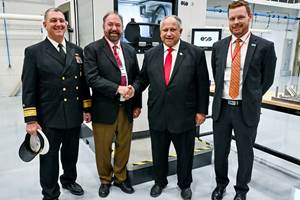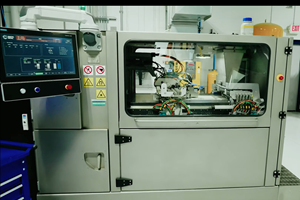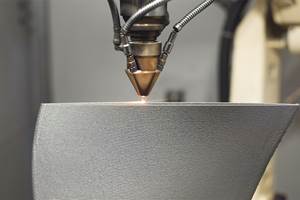An AM Voyage: Seeking Additive Manufacturing’s Next-Gen Metals for Ship-Based Repair
A research team at the University of Pittsburgh’s Swanson School of Engineering is using computational materials design to create new high-strength steels for the United States Navy.
At the height of the Pacific War during WWII, the abilities of American crews to perform damage control on U.S. battleships represented a tremendous advantage over the Imperial Japanese Navy. Most notable, perhaps, were the herculean efforts to repair the USS Yorktown after it suffered a direct hit from a Japanese torpedo during the Battle of the Coral Sea. Soon afterward, U.S. naval intelligence learned that the Japanese were mounting a major offensive in the Midway Atoll northwest of the Hawaiian Islands, and the news sent crewmembers of the Yorktown scrambling to repair and ready the massive aircraft carrier for battle once again. It is in part due to those efforts that the Battle of Midway is today remembered as a decisive American victory and a turning point of the war.
More than 70 years later, damage control—including the real-time manufacturing of parts and components—remains a key focus of the U.S. Navy’s Office of Naval Research (ONR). And, as evidenced by a recent $449,000 grant to the University of Pittsburgh’s Swanson School of Engineering, additive manufacturing promises to play an outsized role in these efforts.
Dr. Wei Xiong, assistant professor in the school’s Department of Mechanical Engineering and Materials Science, helped his research team secure the three-year grant. The team hopes to design, develop, and optimize new alloy compositions for additive manufacturing that can accomplish two critical functions: resist corrosion in maritime environments, and enable rapid, in situ production of parts for maintenance and repair.
The challenge faced by Dr. Xiong and his team is the same challenge faced by metal additive manufacturing writ large: the rapid heating and cooling processes used to create a metal part additively will result in different microstructures—and thus different mechanical properties of the part—than if the same part was produced by traditional manufacturing techniques such as casting. Xiong and his team are therefore taking a materials science approach by first studying how additive processing influences the microstructures of alloy compositions.
Xiong likens the process to a linking chain. By designing an alloy composition specifically for a direct metal laser sintering (DMLS) process—a requirement of ONR’s proposal—Xiong and his team hope to equal or better the mechanical properties of steel parts produced by traditional manufacturing methods. “We have processing influencing the microstructure, and the microstructure influencing the materials properties,” Xiong says. “Usually for getting very good materials, people focus on improving the mechanical properties, like strength. Through our materials science, we know that additive processing actually influences the microstructure in the alloys first, which in turn influences the mechanical properties.”
To achieve this goal, Xiong and his team are employing computational modeling methods that utilize Calculation of Phase Diagrams (CALPHAD —a technique for computational thermodynamics and diffusion in materials science) and integrated computational materials engineering (ICME) to aid materials development and process improvements. Xiong says that roughly 60 percent of his team’s research involves modeling and simulations for developing new materials, while 40 percent involves experimentation and validation processes. “When doing pure computation,” Xiong says, “you always have some difference between the prediction and the experiments. So, we have our Physical Metallurgy and Materials Design Laboratory where we can create, print, and validate an alloy to support our simulation, then those results are used to calibrate our model.”
Using HSLA-100 as a reference for the mechanical properties sought by ONR, Xiong and his team plan to create new powder alloys and build test components through DMLS processing. The team will then perform tensile tests and slice the component into pieces to investigate the part’s microstructure. Any differences between their computer model predictions and the experimental observations will be used to calibrate their simulation models. The process represents a closed loop between the prediction, verification and calibration.
Ultimately, what the Navy seeks is a powder alloy that exhibits the same mechanical properties as an HSLA steel—but one more resistant to corrosion—that can be stored along with 3D printers aboard their vessels. The cost saving opportunities of such an outcome, of course, would be tremendous—as well as transferable to other industries. It’s an exciting proposition for all involved.
3D printing became established in manufacturing thanks to its use initially for making prototype parts. But as Xiong says, “We are trying something new. We are using additive manufacturing processes to help us design prototype alloys.”
Related Content
EOS Works With Phillips Federal, Austal USA to Develop CopperAlloy CuNi30 for US Navy Submarine Industrial Base
Using the copper-nickel alloy in combination with EOS’ platforms offers new design and production capabilities for U.S. Navy submarines, while also enabling the agency to limit global supply chain disruption because parts can be produced regionally, locally and on-demand.
Read MoreAdditive Manufacturing for Defense: Targeting Qualification
Targeting qualification in additive manufacturing for the defense industry means ensuring repeatability as well as reliability as there is much at stake, including human lives. Certain requirements therefore must be met by weapons systems used by the defense industry.
Read MoreFrom Polymer Tooling to Metal Production Via 3D Printing
As Azoth has adopted new additive manufacturing technologies, its work has transitioned from tooling to production parts for automotive, medical and defense.
Read MoreDefense Department Looks to Additive Manufacturing to Propel Hypersonic Systems
The DoD is requesting prototype solutions for its Growing Additive Manufacturing Maturity for Airbreathing Hypersonics (GAMMA-H) challenge as part of the department’s ongoing efforts to expand manufacturing processes for intricate hypersonic weapons parts.
Read MoreRead Next
To Improve Performance of Compression Molded Composites, Add 3D Printed Preforms
9T Labs' Additive Fusion Technology enables the manufacture of composite structures with as much or as little reinforcement as is necessary, using 3D printed continuous fiber preforms to add strength just where needed.
Read MoreVideo: Intelligent Layering Metal 3D Printing at 3DEO
Contract manufacturer 3DEO delivers metal parts using Intelligent Layering, a binder jetting-like 3D printing process the company developed and operates internally. Here’s how it works.
Read More3D Printing Brings Sustainability, Accessibility to Glass Manufacturing
Australian startup Maple Glass Printing has developed a process for extruding glass into artwork, lab implements and architectural elements. Along the way, the company has also found more efficient ways of recycling this material.
Read More









.png;maxWidth=300;quality=90)













